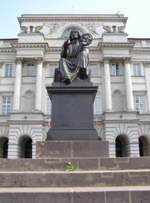- Nicolaus Copernicus Monument in Warsaw
-
 Thorvaldsen's Copernicus Monument before the Polish Academy of Sciences on Warsaw's Krakowskie Przedmieście
Thorvaldsen's Copernicus Monument before the Polish Academy of Sciences on Warsaw's Krakowskie Przedmieście Copernicus soon after the 2008 theft of his armillary sphere.
Copernicus soon after the 2008 theft of his armillary sphere.
The Nicolaus Copernicus Monument in Warsaw is one of the Polish capital's notable landmarks. It stands before the Staszic Palace, the seat of the Polish Academy of Sciences on Krakowskie Przedmieście. Designed by Bertel Thorvaldsen in 1822, it was completed in 1830.
Contents
History
The bronze statue of astronomer Nicolaus Copernicus (Polish: Mikołaj Kopernik) holding a compass and armillary sphere was designed by Bertel Thorvaldsen in 1822 and erected in 1828–30.[1] It was funded[2] by public donations and by the scientist and philosopher Stanisław Staszic,[1]. The unveiling ceremony, presided over by Tadeusz Kościuszko's former comrade-in-arms, Julian Ursyn Niemcewicz. Polish clergy refused to attend the ceremonies as his book had been condemned by the Holy Office in 1616.[3]
Staszic had originally planned to erect the statue in Toruń, Copernicus' hometown, upon hearing that Napoleon had expressed surprise during an 1807 visit to Toruń that there was no monument to Copernicus in the town.[4] The fall of the Duchy of Warsaw (which had included Toruń) and the reoccupation of the region by Prussia had delayed the project and eventually forced Staszic to change the venue to Warsaw, which was in the Russian partition.[4]
The east face of the pedestal bears the inscription, "Nicolo Copernico Grata Patria" (Latin: "To Nicolaus Copernicus [from a] Grateful Nation"), and the west face—"Mikołajowi Kopernikowi Rodacy" (Polish: "To Mikołaj Kopernik [from his] compatriots").[5]
During World War II, the Copernicus monument was the focus of a notable "minor-sabotage" operation by the Polish underground. Soon after the Nazi German occupation of Warsaw in 1939, the Germans effaced the Latin and Polish inscriptions and attached a plaque in German language: "To Nicolaus Copernicus [from] the German Nation".[5] On 11 February 1942 Maciej Aleksy Dawidowski removed the German plaque.[6] In response, on 21 February, the Germans moved Warsaw's statue of Jan Kiliński to the National Museum in Warsaw.[6] Dawidowski and his comrades retaliated by placing a large graffito on the Museum ("People of Warsaw—I am here. Jan Kiliński") and on 13 March adding a new plaque to the Copernicus monument: "For removal of the Kiliński statue, I am extending the winter by two months. Kopernik."[7]
In 1944, after the Warsaw Uprising, in which the monument was damaged, the Germans decided to melt it down. They removed it to Nysa, but had to retreat before they could melt it down.[1] The Poles brought the monument back to Warsaw on 22 July 1945, renovated it, and unveiled it again on 22 July 1949.[1]
In 2007 a bronze representation of Copernicus' solar system, modelled after an image in his De revolutionibus orbium coelestium, was placed on the square before the monument.[8][9][10] In July 2008 the statue was vandalized, but the stolen parts were soon recovered.[11]
Replicas of Warsaw's Copernicus monument stand in Montreal and Chicago.
See also
- Nicolaus Copernicus Monument in Kraków
- Nicolaus Copernicus Monument in Toruń
- Siege of Allenstein
Notes
- ^ a b c d (Polish) "Pomnik Kopernika" ("Copernicus monument"), Architektura przedwojennej Warszawy (The Architecture of Prewar Warsaw).
- ^ The statue which I have just mentioned was erected at the expense of the Polish nation, by means of a subscription, and 40,000 florins being still required to defray the cost, the deficit was made up by the Abbe Staszic, a learned Minister of State, from his private fortune. - Eugène Plon: Thorvaldsen: his life and works, R. Bentley and Son, 1874 p. 71
- ^ Popular Science, June 1891 p. 261
- ^ a b Stephen P. Mizwa, Nicholas Copernicus 1543-1943, New York, Kościuszko Foundation, 1943; Kessinger Publishing, 2006, ISBN 1428654585, Google Print, pp. 49-50.
- ^ a b Stephen P. Mizwa, Nicholas Copernicus 1543-1943, New York, Kościuszko Foundation, 1943; Kessinger Publishing, 2006, ISBN 1428654585, Google Print, p. 51.
- ^ a b (Polish) Tomasz Stańczyk, "Piasek sypany w oczy" ("Sand Thrown in the Eyes"), Rzeczpospolita, Dodatek Specjalny (Special Supplement), 29.05.04, no. 125.
- ^ Jerzy Einhorn, Recollections of the End of an Era: Poland 1919-1945, Author House, 2005, ISBN 1420803549, Google Print, pp. 128-29.
- ^ (Polish) Przebudowa Krakowskiego Przedmieścia w Warszawie (Reconstruction of Warsaw's Krakowskie Przedmieście).
- ^ (Polish) Dariusz Bartoszewicz, "Ruszyli Słońce, ruszyli Ziemię" ("They Moved the Sun, They Moved the Earth"), Gazeta Wyborcza - Gazeta Stołeczna, Thursday, 31 May 2007.
- ^ (Polish) Dariusz Bartoszewicz, "Układ Kopernikański odlany z brązu" ("Copernican System Cast in Bronze", Gazeta Wyborcza Stołeczna, 2007-01-18.
- ^ (Polish) "Kto ukradł układ Kopernika?" ("Who Stole Copernicus' System?"), Gazeta Wyborcza Stołeczna, 2008-07-03.
Further reading
- "Pomniki" ("Monuments"), Encyklopedia Polski, p. 529.
Coordinates: 52°14′17.40″N 21°1′04.75″E / 52.238167°N 21.0179861°E
Categories:- 1822 works
- Buildings and structures in Warsaw
- Monuments and memorials in Poland
- Sculptures by Bertel Thorvaldsen
Wikimedia Foundation. 2010.




